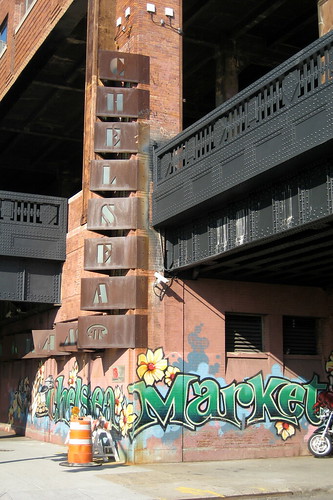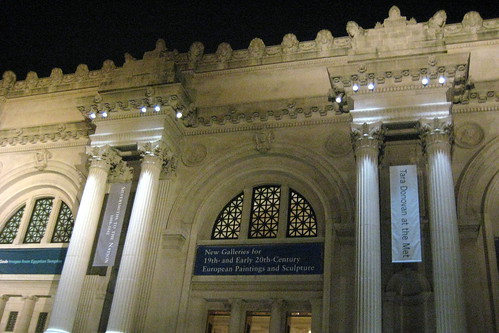Some cool American League Central images:
NYC – Chelsea: Chelsea Market

Image by wallyg
Chelsea Market is situated within a two-block complex, filling one million square feet and 18 buildings between 9th and 11th Avenues. The factory, office and railroad complex was built between 1890 and the mid 1930s for the New York Biscuit Company, an almagamation of 8 large eastern bakeries formed in 1890. It started off as a Romanesque-style complex of six-story bakeries on the east side of 10th Avenue, designed by Romeyn & Stever. shortly after the 18989 merger with the American Biscuit Company and the United States Baking Company, forming the National Biscuit Company (NABISCO), a collection of 114 bakeries, the complex grew to cover most of the block back to Ninth Avenue.
A series of orange brick structures at the northwestern corner of 15th and 9th designed by Albert G. Zimmerman were added from 1905-1912. In 1912, Zimmerman added the 11-story full-block structure from 10th to 11th on landfill. Nabisco began acquiring the outlying property, like the old American Can Company building on 14th Street, which was connected by a pedestrian bridge, designed by James Torrance. In 1932, Louis Wirsching Jr. replaced some of the original bakeries with the present structure, accomodating the elevated freight railroad viaduct, today known as the High Line, and adding the Art Deco pedestrian bridge crossing 10th Avenue.
Nabisco abandoned the complex for New Jersey starting in the mid-1940’s, and sold the building to Louis J. Glickman in 1958, but during that time the ovens here baked everything from Saltines to Mallomars to Animal Crackers to Oreos, which were first produced in Chelsea in 1912.
In the 1990’s, Irwin B. Cohen organized a syndicate to buy the building and in 1998, Vaneberg Associates renovated the complex. Brass spandrels were woven into the 9th Avenue brick facade, and a glass and steel canopy was added. The back lots of the individual buildings were connected to an 800-foot long central, ground-level concourse with entries at 9th and 10th Avenues. The original flooring was kept in tact, enhanced with light panels. Diamondplate panels, rebar handrails, stone sculpture, aluminum, glass block, and recycled industrial objects were used throughout. A central fountain contains discarded drill bits. Storefronts opened to the concourse with floor to ceiling glass. Anchor stores include the Manhattan Fruit Exchange, 202 by Nicole Farhi, Amy’s Bread, and Buddakan. Other popular shops include Fat Witch Bakery, Ruthy’s Baked Goods, Eleni’s, The Lobster Place, Ronnybrook Dairy, and Chelsea Wine Vault. In 2006, Morimoto, owned by "Iron Chef" Masaharu Morimoto opened on the 10th Avenue side, across from where fellow "Iron Chef", Mario Batali opened Del Posto. The Food Network films its shows Iron Chef America and Emeril Live in the Chelsea Market. The complex also contains office and studio space for other media companies including NY1, The Oxygen Network and Major League Baseball Productions.
NYC – Metropolitan Museum of Art

Image by wallyg
The Metropolitan Museum of Art’s permanent collection contains more than two million works of art from around the world.
In 1866 a group of Americans were visiting Paris taking in the cultural delights of the Old World and it occurred to some of them that New York deserved a world class art museum. To that end John Jay, President of the Union League Club gave a speech declaring "America needed a National Institution and Gallery of Art and that the American gentlemen then in Europe were the men to inaugurate that plan." The art committee of the Union League Club, in concert with other prominent citizens, led the way with the museum to be established by an act of the New York State Legislature in 1870. The Metropolitan Museum of Art first opened its doors on February 20, 1872, housed in a building located at 681 Fifth Avenue in New York City. John Taylor Johnston, a railroad executive whose personal art collection seeded the museum, served as its first President, and the publisher George Palmer Putnam came on board as its founding Superintendent. Under their guidance, the Met’s holdings, initially consisting of a Roman stone sarcophagus and 174 mostly European paintings, quickly outgrew the available space. In 1873, occasioned by the Met’s purchase of the Cesnola Collection of Cypriot antiquities, the museum decamped from Fifth Avenue and took up residence at the Douglas Mansion on West 14th Street. However, these new accommodations were temporary; after negotiations with the city of New York, the Met acquired land on the east side of Central Park, where it built its permanent home, a red-brick Gothic Revival stone "mausoleum" designed by American architects Calvert Vaux and Jacob Wrey Mold. The Met has remained in this location ever since, and the original structure is still part of its current building. A host of additions over the years, including the distinctive Beaux-Arts facade, designed by Richard Morris Hunt and completed in 1926, have continued to expand the museum’s physical structure. As of 2006, the Met measures almost a quarter mile long and occupies more than two million square feet, more than 20 times the size of the original 1880 building.
In 2007, the Metropolitan Museum of Art was ranked #17 on the AIA 150 America’s Favorite Architecture list.
The Metropolitan Museum of Art was designated a landmark by the New York City Landmarks Preservation Commission in 1967. The interior was designated in 1977.
National Historic Register #86003556
